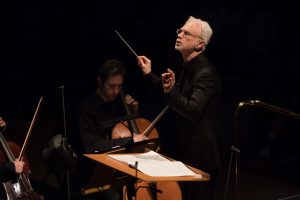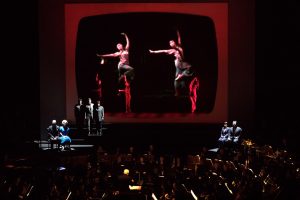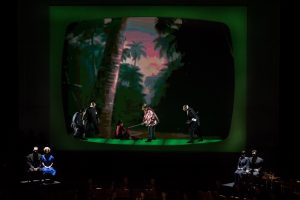LET ME MAKE THIS PERFECTLY CLEAR
Prior to yesterday’s matinee, the last of a two-performance run of Nixon in China presented by LA Phil, I wondered who would make up the audience for a revival of John Adams’ first opera: Opera fans who would see anything labeled “opera”?; those who enjoy that 80s’ minimalist style, perfected by Philip Glass?; patrons who have season subscriptions, and this event just happened to be part of their package?; or would they be theater lovers?; or simply curious? I had never seen it before simply because productions are rare.
Here’s why I ask: There were a shocking number of scattered empty seats which had been sold (“shocking” given that all of Disney Hall’s seats behind the stage were covered over by the set, and that limited tickets). Additionally, even more seats were abandoned during the intermission of the three-hour three-act, one which was given a fantastic, ginormous production conducted by the composer himself. (Sitting in an “obstructed view” seat, I entertained the thought of moving after the break, but I always feel that’s a very uncool thing for press to do; in hindsight, while I liked being closer to the players, I would have enjoyed a better view of the visuals much more.)
So here is a universally praised opera in its second and final performance sung by the best and played by the best, but patrons, from what I can tell, don’t seem buzzed about it.
Here’s what I believe. Nixon in China, which spawned a new era of minimalist opera that continues 30 years later since its premiere at Houston Grand Opera, is a grand experiment more than a fully realized work. At turns it is hypnotic, explosive, terrifying, and intellectually provocative, but other parts’”especially in Act I and the latter part of Act III’”are repetitive and atonal to the point of being annoying and soporific (and you should know I loved loved loved Philip Glass’s minimalist operas, Einstein on the Beach and Akhnaten).
I was thrilled by the entire second act (from what I could see at my disadvantaged vantage point) and some of the third, but ultimately this piece is similar to Adams’ entire oeuvre: All of the orchestrations are interesting (he uses saxophones here); some of it is gorgeous and lush; and some of it soul-pounding and exciting. But too much of it is head-scratchingly implacable and impenetrable. This may be fun, challenging work for players and fascinating to fellow musicians and opera lovers, but I am simply not sold.
 It’s such a smart idea for an opera, too (it’s the brainchild of Peter Sellars, who approached Adams to write what is now one of his most famous compositions): Like it or not, President Nixon’s visit to China in 1972 is responsible for the U.S.’s open-trade policy with China. Nixon and First Lady Pat were the first official American visitors to the People’s Republic of China since Mao Tse-tung’s communist takeover in 1949. This was an important event because the U.S. was seeking to improve relations with a Communist country during the Cold War.
It’s such a smart idea for an opera, too (it’s the brainchild of Peter Sellars, who approached Adams to write what is now one of his most famous compositions): Like it or not, President Nixon’s visit to China in 1972 is responsible for the U.S.’s open-trade policy with China. Nixon and First Lady Pat were the first official American visitors to the People’s Republic of China since Mao Tse-tung’s communist takeover in 1949. This was an important event because the U.S. was seeking to improve relations with a Communist country during the Cold War.
First-time librettist is poet Alice Goodman, whose only other libretto was also a collaboration with Adams: the painfully leaden and equally overpraised The Death of Klinghoffer (seen at Long Beach Opera in 2014), which should have been controversial for how it sounded, not what it’s about. Nixon in China is written in rhymed octosyllabic couplets’”stanzas in which each of the two lines contains eight syllables: “Behemoth pulls the peasant’s plow.” Her language can be fascinating but also dense and esoteric; combined with Adams’ highly repetitive, melodically schizophrenic lines, I would warn some to be prepared for ennui cubed. Any possibility for realistic action and expression is intentionally snuffed. Sometimes it’s like watching slow motion home movies. And when characters sing passages of self-explanation’”announcing their outlook and emotions instead of interacting naturally’”it’s downright dull. This kind of verse could have them running to the exits. Oh, they did.
Vocally, Nixon in China was a resounding success. All of the principals flourished: a solid Ryan McKinny as Nixon; Joélle Harvey, multi-dimensional in diction and style as Pat; baritone Joo Won Kang as Chou En-Lai, the country’s first Premier; the magnificent John Matthew Myers, a late replacement to the production, was impressively nonchalant about his ridiculous range as Mao; and powerhouse Kathleen Kim as Madame Mao, the Chairman’s fourth wife named Chiang Ch’ing. Henry Kissinger, who accompanied the Nixons on their historic visit, is a smaller role but Peter Coleman-Wright leaves a mighty impression. Overall, the dramatic emphasis here is the difference of these characters, especially as it relates to their public and private sides, and the collision of two great theories on how people should live: Communism versus Capitalism.
Act I leans towards realism, Act II surrealism, and Act III reflection. I like how the score keeps this from being a mere historical travelogue, but interestingly enough, the parts that worked best were those in Act II that did just that: After Pat visits a glass elephant factory, a pig farm, and a children’s classroom, the Nixons attend a State-sponsored performance of Madame Mao’s ballet, The Red Detachment of Women (the lead dancer, Jasmine Perry, was choreographed by Leslie Stevens to act like a music box dancer en pointe). During the performance, which increasingly becomes propagandist camp, Pat is drawn into, and makes comments about, the work, while the villain of the piece is played by the actor playing Kissinger. The dance ends with Madame Mao’s defiant aria, “I Am the Wife of Mao Tse-Tung,” which saw Ms. Kim slicing through her high notes with incisive creepiness. (Three imperious secretaries were played to the hilt by Lacey Jo Benter, Renée Rapier and Rachael Wilson.)
As with her park-and-bark staging of LA Opera’s Lucia di Lammermoor, director Elkhanah Pulitzer had mostly stagnant principals here. But she wisely used the actual astounding video footage from the trip, most of it from Super 8 cameras (Bill Morrison was the film designer), projected onto a giant TV screen, behind which is a playing area (this was the space obstructed from my view). A four-step riser was in front of the sometime transparent screen. The work of Alexander V. Nichols (set and projection) and David Finn (lights) was exemplary for this house and the cramped quarters on stage.
Costumer Elizabeth Scott nailed the realistic clothes and hairstyles, and the Los Angeles Master Chorale (which mostly stayed stage right and left) wore pea-green neck scarves over unisex black slacks, shirts and shoes (LAMC is never ever short of flawless). Mark Grey’s sound superbly overcame both Adams’ youthful conducting and Disney Hall’s tricky amplification issues. Nonetheless, I’m glad there were supertitles over the stage, even though bouncing between them and the actors was exhausting from my seat. And whoever created the programs as facsimiles of Mao’s Little Red Books should receive an award in design.
Nixon’s trip to China was a political breakthrough, but The Tiananmen Square Incident and the new “Made in China” ethic means the U.S. will always have to rethink and reformulate relations with China. Adams’ opera may have been critically important at the time it was written, but I think it’s high time we rethink and reformulate modern opera.
 photos by Craig T. Mathew/Mathew Imaging
photos by Craig T. Mathew/Mathew Imaging
Nixon in China
Los Angeles Philharmonic
John Adams, conductor
Walt Disney Concert Hall
135 North Grand Avenue
played March 3 and 5 (date of review), 2017
for future events, call 323.850.2000 or visit LA Phil




















{ 4 comments… read them below or add one }
Hmm? It truly is silly to write a review such as this when you essentially saw the performance with a bag over your head. Further, this is not a Docuopera. Better preparation would have revealed the aspects of the text and music that apparently drifted over your cloaked eyes. Bizarre too that you readily admit you had an obstructed view – likely as much figurative as literal.
Those familiar with the work found this performance outstanding, especially the cinematic projection artfully syncopated with the score and the live singers.
Your comments betray your ignorance. You obviously have never listened to this piece before. It is clear you did not read, let alone, study the libretto or its preparation.
It’s certainly fine to attend a work without knowing it, however if you are going to review, do the work then know it well. You don’t.
The work wax performed in San Diego 2 years ago, in Long Beach 5 years ago and at the Metropolitan Opera about 6 years ago which resulted in DVD. This opera is not all that rare and demonstrably not as ill-finished and trite as your blather.
Dude, I’d advise you to pass on opera in the future since you aren’t willing to do the work ahead of time.
Wolfgang, you nailed this response. I couldn’t agree more, well said.
I saw Nixon in China on the Friday night performance. And while I like the opera itself from start to finish, I can understand Mr. Frankel’s arguments (caveat: I have been reading his reviews for years and this is the first time I remember disagreeing with him about an actual score). It’s funny how both comments here (Wolfgang and Chad) castigate the reviewer for not being present at the opera, but I feel they didn’t really READ this critique.
Frankel writes that he appreciates that the score isn’t a mere historical travelogue; he was just saying the middle act (which is admittedly the best) worked better for him than the first and third. And I agree that about six major productions (more or less) of a work from 1987 can indeed be called “rarely produced.â€
And why does Wolfgang say that you have to know a work if you’re going to review it? What if it’s a brand new opera? Is he saying, if you study a work beforehand you’ll cheer it? Or understand it better? Silly. And while Mr. Frankel speaks for himself, Wolfgang states that those familiar with the work found this performance outstanding; how can he speak for an entire audience?
And by the way nowhere does Frankel say that the performance isn’t outstanding–and even mentions the great video work and the singers et al. There’s nothing about it he doesn’t praise. He is looking at the difference between the WRITTEN opera and the PERFORMED opera. I also agree that, while I love the music, the libretto can be a bit tricky to follow.
But why am I writing this? I also noticed some empty seats at the start of the sold out show (I assume it was sold out; my friend couldn’t get tickets). Even more surprising is how many people left after intermission (how sad for them!). I feel this reviewer is right on the money to question why some of us staunchly defend this opera while others walk out.
All I can say is I love this unique opera and its radicalism, but Mr. Frankel is reporting accurately about the production (and the obstructed seats, which I also had). Instead of nasty responses to this review, I wish people would simply say what they love about the show instead of assassinating the writer here.
Consider the silly review by Max Frankel of the Met production in 2011. Indeed, this is not a docu-opera, and never intended as such. As if any opera were intended as a documentary.